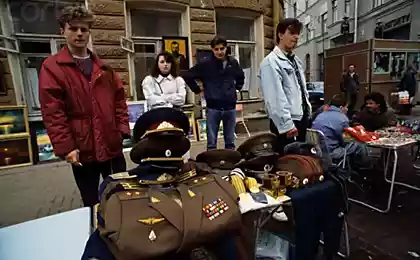723
Trade, as an art
Approach to the issue of trafficking at different times in different countries. Cool.

1940
The seller puts the goods on the shelves in a grocery shop.
1941
Woman doing shopping in a department "Accessories»
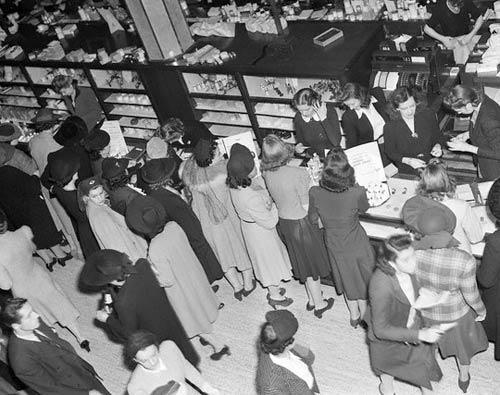
1941
Department of "Perfumes»

1950
Record store.

1951
Exhausted damned capitalism workers crammed for nickel-plated pans on seasonal sales.

1951
New York. Children look at the Christmas show in the window. By the way, American children's clothing in 1951 resembles the clothes of Soviet children in the 70s. I, for example, had a similar coat tsigeykovoy lining and fur collar.

1951
Automatic laundry in the supermarket.

1951
Women buy hair dryers, electric mixers, electric irons, elektrovafelnitsy and so on. Let me remind you - it's 1951
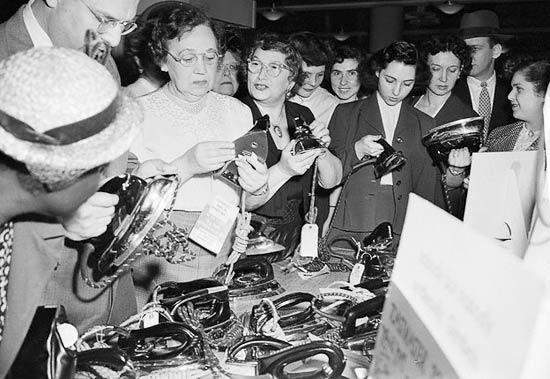
1951
Seller explains the benefits of electric iron buyers. In principle, this photograph can easily be called "The Soviet electronics store." Only a year would have to be changed from 1951 on, for example, in 1975 then no one would have noticed the fraud.

1952
The boy looks at the window of a toy store. In principle, I can assume that in the 60s in the USSR also have had similar showcases toys.
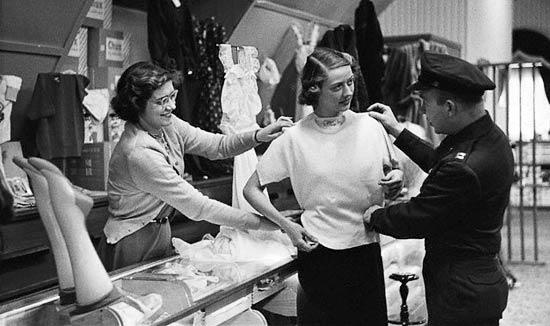
1952
The guard makes a purchase to his wife.
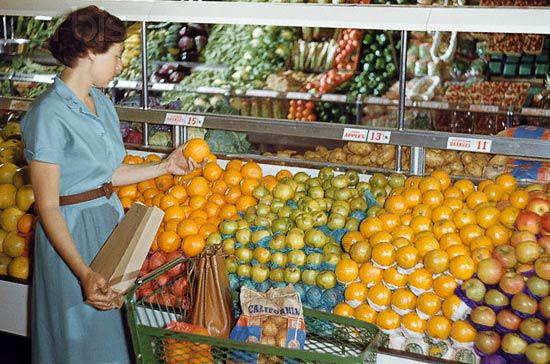
1952
Normal fruit department. In the USSR, these never did. By the way, note paper kulёk. It was the same in the USSR in the 70-80s. Actually, I think that their idea in the US and slyamzili. I'm talking about these paper bags below will outline a couple of comments.

1953
Department "Newspapers and magazines". Bright and colorful children's books - comics, I suppose. 1953 ...

1953
Former US President Harry Truman brazenly and cynically exploits the unfortunate blacks without leaving the barber shop (but then they still were not blacks, and blacks were common). By the way, the interior of the barber shop is very reminiscent of the interiors of the Soviet hairdressing 70s. In general, selecting photos, I have concluded that the Soviet Union brazenly lyamzil design ideas from their ideological enemies. But with the introduction of late years to 20.
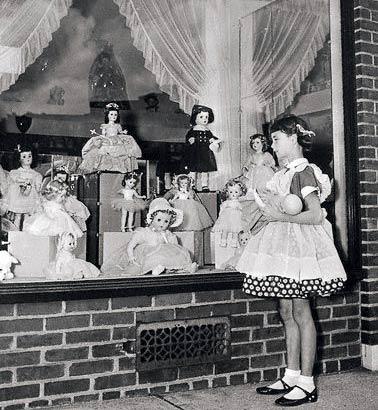
1954
Girl near showcase toys. In Soviet times, this image necessarily would sign something like this: "The American schoolgirl sadly looks at the elegant display case, not having the money to buy even dolls" and the doll in his hand girl to retouch.
1954
Where I found this photograph, she was signed: "Watching TV in the pharmacy." Hmm. So it is a pharmacy.

1954
Fighters for the Stalinist legacy of love to tell that in the 50 years under Stalin in the Soviet Union was lowered prices. As we see in the US in the 50s, prices also declined. The truth is not sure that in 1954 the Soviet Union sold the jar of instant coffee.

1955
American boy in a toy store.

1955
Father and son in the fruit department.
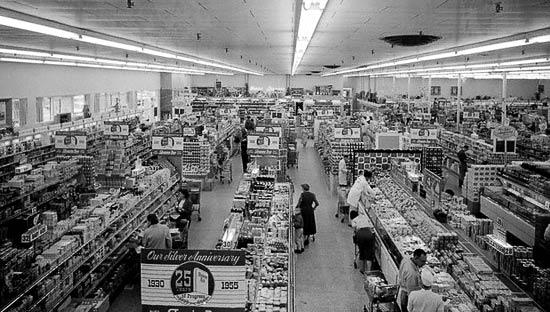
1955
California. Inside the supermarket.

1955
The Chinese began to invade the US in the 50s. Chinese supermarket.
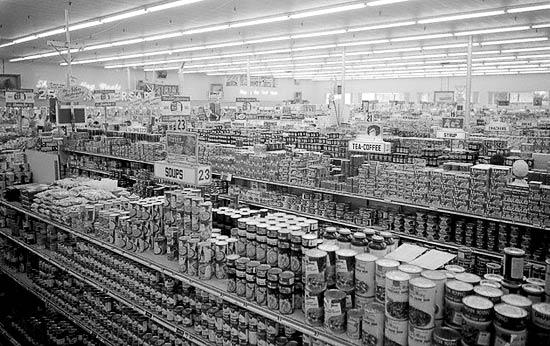
1955
Another supermarket.

1955
And more.

1956
This picture is reminiscent to me here this: pics.livejournal.com/germanych/pic/00018fb4. The only difference is that the people here do not fight, and smile. A salesman seem more and persuades people to buy meat (though it may mocks buyers who can not buy meat?). Infamous grin of capitalism.

1956
Some rural shop.
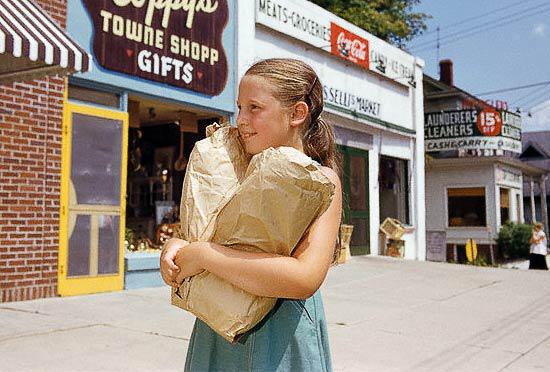
1956
Girl with shopping bags. So, once again about eco-friendly bags. I agree that paper bags for the environment is better than plastic. However, when everything is so elegant and colorful, as in this picture, light brown packages (fruit and vegetable) look quite stylish. However, in the gray atmosphere Sovdep exactly the same packages looked depressingly dull.
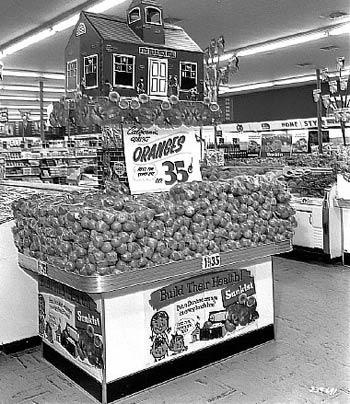
1956
Window dressing in the supermarket.

1956
Ice Cream. Thirty cents for a pint. Or dollar-five cents for a half-gallon. Look, a reptile dealer, smiling, enticing buyers. No menacing to look at the kids like a real Soviet seller.

1956
Even some Supermarkets.

1957
Toy boy. In principle, nothing outstanding. But in the USSR and in the 70s such toys would make the owner of the center of attention of the court.

1957
Interior some diner. In the background, near showcases something like a lollipop. In the USSR, something like a lollipop (lollipop on a stick-males) sold Gypsies.
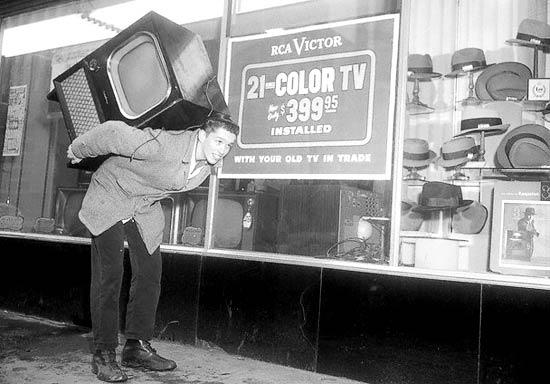
1958
I, unfortunately, did not find, what was the American worker salary in 1958. But in terms of the 70s I think that $ 400 a month received the American worker. If so, then in 1958 he was able to buy a color TV with 21-inch, paying him a monthly salary. Soviet worker can buy a color TV in 1975, and paid for it four monthly salaries. And how could the Soviet working to buy a color TV in 1958?

1959
Merchandising. I apologize for expression

1959
Well, it is, the outer shell. Making of the American streets.

1940
The seller puts the goods on the shelves in a grocery shop.

1941
Woman doing shopping in a department "Accessories»

1941
Department of "Perfumes»

1950
Record store.

1951
Exhausted damned capitalism workers crammed for nickel-plated pans on seasonal sales.

1951
New York. Children look at the Christmas show in the window. By the way, American children's clothing in 1951 resembles the clothes of Soviet children in the 70s. I, for example, had a similar coat tsigeykovoy lining and fur collar.

1951
Automatic laundry in the supermarket.

1951
Women buy hair dryers, electric mixers, electric irons, elektrovafelnitsy and so on. Let me remind you - it's 1951

1951
Seller explains the benefits of electric iron buyers. In principle, this photograph can easily be called "The Soviet electronics store." Only a year would have to be changed from 1951 on, for example, in 1975 then no one would have noticed the fraud.

1952
The boy looks at the window of a toy store. In principle, I can assume that in the 60s in the USSR also have had similar showcases toys.

1952
The guard makes a purchase to his wife.

1952
Normal fruit department. In the USSR, these never did. By the way, note paper kulёk. It was the same in the USSR in the 70-80s. Actually, I think that their idea in the US and slyamzili. I'm talking about these paper bags below will outline a couple of comments.

1953
Department "Newspapers and magazines". Bright and colorful children's books - comics, I suppose. 1953 ...

1953
Former US President Harry Truman brazenly and cynically exploits the unfortunate blacks without leaving the barber shop (but then they still were not blacks, and blacks were common). By the way, the interior of the barber shop is very reminiscent of the interiors of the Soviet hairdressing 70s. In general, selecting photos, I have concluded that the Soviet Union brazenly lyamzil design ideas from their ideological enemies. But with the introduction of late years to 20.

1954
Girl near showcase toys. In Soviet times, this image necessarily would sign something like this: "The American schoolgirl sadly looks at the elegant display case, not having the money to buy even dolls" and the doll in his hand girl to retouch.
1954
Where I found this photograph, she was signed: "Watching TV in the pharmacy." Hmm. So it is a pharmacy.

1954
Fighters for the Stalinist legacy of love to tell that in the 50 years under Stalin in the Soviet Union was lowered prices. As we see in the US in the 50s, prices also declined. The truth is not sure that in 1954 the Soviet Union sold the jar of instant coffee.

1955
American boy in a toy store.

1955
Father and son in the fruit department.

1955
California. Inside the supermarket.

1955
The Chinese began to invade the US in the 50s. Chinese supermarket.

1955
Another supermarket.

1955
And more.

1956
This picture is reminiscent to me here this: pics.livejournal.com/germanych/pic/00018fb4. The only difference is that the people here do not fight, and smile. A salesman seem more and persuades people to buy meat (though it may mocks buyers who can not buy meat?). Infamous grin of capitalism.

1956
Some rural shop.

1956
Girl with shopping bags. So, once again about eco-friendly bags. I agree that paper bags for the environment is better than plastic. However, when everything is so elegant and colorful, as in this picture, light brown packages (fruit and vegetable) look quite stylish. However, in the gray atmosphere Sovdep exactly the same packages looked depressingly dull.

1956
Window dressing in the supermarket.

1956
Ice Cream. Thirty cents for a pint. Or dollar-five cents for a half-gallon. Look, a reptile dealer, smiling, enticing buyers. No menacing to look at the kids like a real Soviet seller.

1956
Even some Supermarkets.

1957
Toy boy. In principle, nothing outstanding. But in the USSR and in the 70s such toys would make the owner of the center of attention of the court.

1957
Interior some diner. In the background, near showcases something like a lollipop. In the USSR, something like a lollipop (lollipop on a stick-males) sold Gypsies.

1958
I, unfortunately, did not find, what was the American worker salary in 1958. But in terms of the 70s I think that $ 400 a month received the American worker. If so, then in 1958 he was able to buy a color TV with 21-inch, paying him a monthly salary. Soviet worker can buy a color TV in 1975, and paid for it four monthly salaries. And how could the Soviet working to buy a color TV in 1958?

1959
Merchandising. I apologize for expression

1959
Well, it is, the outer shell. Making of the American streets.








